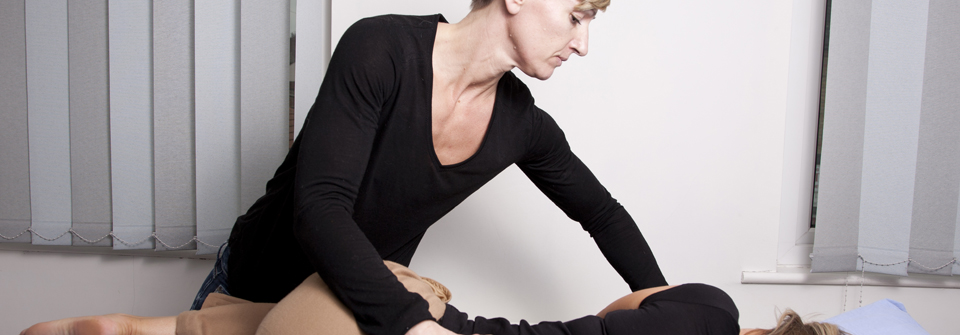What is osteopathy?
Osteopathy works on the basis that each person’s bones, muscles, ligaments and connective tissue must work smoothly together to achieve wellbeing. An osteopath uses their hands to treat patients by moving, manipulating, stretching and massaging their muscles, limbs and joints.
This helps to bring balance to the body by improving the function of joints, increasing the blood supply to tissues and helping to alleviate any tension in the muscles to help the body to heal.
Osteopathy is holistic – looking at the whole person, rather than just the area that’s injured.
Osteopaths are trained in orthopaedics, biomechanics and pathology so are well placed to understand the mechanics of injury to get to the root cause of pain, ensuring long term relief.

What can I expect at an osteopath consultation?
Your first appointment with us is up to 60 minutes, during which we’ll discuss the ailment you’re experiencing; how the injury occurred, how long you’ve had it, how painful it is and so on. We will then perform an examination with you standing and sitting. You’ll also lie on a couch and we will assess your tissues with our hands . Depending on the area of pain we may move your limbs to see how your body is working and what is likely to be causing the pain. Other medical examinations and tests, for example blood pressure, may be performed.
Your diagnosis and prognosis with be explained to you before your the treatment begins, which may include, manipulation (the osteopathic ‘click’), stretching and massage to improve the function of your joints, muscles and ligaments. This helps the blood and nerve supply to your tissues, helping your body to heal and repair itself.
We may recommend a series of sessions to treat the pain, and the number of sessions required will depend on the injury and the individual. We may also give advice on posture, ergonomics, lifting, exercise and nutrition to help prevent future episodes recurring.
As each person that comes to us is different, so treatment is unique to each person.
Training and qualifications
All osteopaths practising in the UK have completed rigorous training. Students follow a four or five-year degree course during which they study orthopaedics, pathology and neurology, as well as pharmacology, nutrition and biomechanics. In addition they undergo a minimum of 1,000 hours of clinical training before they graduate. The majority of people studying osteopathy today take a Masters degree in osteopathy (MOst).
In order to call yourself an Osteopath you have to be registered with the General Osteopathic Council (GOsC), and renew your registration every year. It is illegal to call yourself an osteopath unless you are registered with the GOsC, have completed the appropriate training, hold malpractice insurance and complete 30 hours of studying each year.
What can an osteopath treat?
We see people with many conditions. Some people think Osteopathy is just for treating a bad back, but there are many other conditions we treat:
• Osteoarthritis
• Joint aches and pain
• Rheumatoid Arthritis*
• RSI
• Disc pain
• Muscle tears/strains
• Sports injuries
• Back pain in pregnancy
• Whiplash Injuries
• Headaches
• Sciatica Tennis/Golfers Elbow
• Anterior knee pain
• Adhesive Capsulitis
*Osteopathy is beneficial in relieving pain, improving joint function, muscular tone in these conditions. RA is not treated in acute phases.
We also offer patients advice with:
• Prevention of injury
• Lifting, postural and workstation advice
• Exercise advice and prescription
• Offer advice for supports, mattresses and pillows
We’re also finding more and more sports organisations are contacting local osteopaths. In many cases, osteopaths are replacing physiotherapists in rugby, football and athletics, as more sports are seeing the advantages that osteopathy has to offer.
Any other reasons to see an osteopath?
Osteopathy is effective in dealing with musculoskeletal pain without the use of drugs or other more invasive therapies.
We don’t have any waiting lists and you can usually be seen within a day or two.



Add Comment